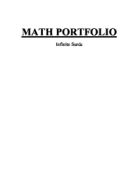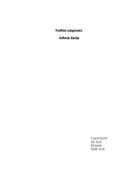Calculate the decimal values of the first ten terms of the sequence.
* Specific manipulation method?
The table below lists the decimal approximations for the first 10 terms of the sequence. It also states the difference between an and an+1.
* Double check figures
* Note: Consistent number of decimal places with second surd
Using technology, plot the relation between n and an.
* Specify technology?
The values are plotted in the graph below showing the relationship between n and an.
Describe what you notice.
By plotting the relation between n and an, we can observe that there is a positive relationship between n and an. That is, as n increases, an also increases.
However, the increase of an is not proportional to the increase of n. an increases at a decreasing extent. That is, each time it increases less than before. The scatter plot seems to have a horizontal asymptote at y=1.618. The value of an approaches approximately 1.618 (i.e. an≈1.618) but never reach it.
In other words, as n gets larger, the difference with the successive term (also shown in the figures in the “an+1 - an” column of the table) is gradually decreasing and almost reaches 0.
What does this suggest about the value of an- an+1 as n gets very large?
The above observation suggests that as n gets very large and at a certain large enough point, an will cease to increase and remain stable at a value. The graph will then follow a straight horizontal line.
In other words, as n approaches infinity, the value of an- an+1 approaches 0. To express in numerical notations, as n→∞, an=an+1.
Use your results to find the exact value for this infinite surd.
The above analysis so far only shows that an≈1.618. To find the exact infinite value for this sequence, we need to rearrange the recursive formula an+1=1+an.
As mentioned, as n→∞, an=an+1. The recursive formula becomes an=1+an.
(Alternatively, as n→∞, the recursive formula becomes a∞=1+a∞… etc.)
Let an=x. Then x=1+x.
So,
x2=1+x
x2-x-1=0
Using the quadratic formula,
x=-b±b2-4ac2a= -(-1)±(-1)2-41(-1)2(1)=1±52
The value of x must be positive, because an is going to be inside the radical of a square root. Also, as the plotted graph shows, there is no negative value of an. The value of 1-52 does not fit in the problem and should be disregarded.
Therefore, the exact value of x=an=1+52 ≈1.618033988750.
* May do further research and add information about golden ratio
Consider another infinite surd
2+2+2+2+2+…
where the first term is 2+2. Repeat the entire process above to find the exact value for this surd.
* Summarize if necessary
To find the exact value for this surd, the same process is repeated and 1 is replaced by 2.
a1=2+2
a2=2+2+2 = 2+a1
a3=2+2+2+2 = 2+2+a1 = 2+a2
Based on the observe sequence, we can observe that the formula for an+1 (a recursive form) can be written in terms of an as: an+1=2+an.
* Specific manipulation method?
The table below lists the decimal approximations for the first 10 terms of the sequence. It also states the difference between an and an+1.
* Double check figures
* Note: Consistent number of decimal places with first surd
The values are plotted in the graph below showing the relationship between n and an.
* Specify technology?
(Graph)
By plotting the relation between n and an, we can observe that there is a positive relationship between n and an. That is, as n increases, an also increases.
However, the increase of an is not proportional to the increase of n. an increases at a decreasing extent. That is, each time it increases less than before. The scatter plot seems to have a horizontal asymptote at y=2. The value of an approaches approximately 2 (i.e. an≈2) but never reach it.
In other words, as n gets larger, the difference with the successive term (also shown in the figures in the “an+1 - an” column of the table) is gradually decreasing and almost reaches 0.
The above observation suggests that as n gets very large and at a certain large enough point (when n = 17), an will cease to increase and remain stable at a value. The graph will then follow a straight horizontal line.
In other words, the value of an- an+1 will approach 0. To express in numerical notations, an=an+1.
To find the exact infinite value for this sequence, we need to rearrange the recursive formula an+1=2+an.
As mentioned, as n increases to a certain point, an=an+1. The recursive formula becomes an=2+an.
(Alternatively, as n→∞, the recursive formula becomes a∞=1+a∞… etc.)
Let an=x. Then x=2+x.
So,
x2=2+x
x2-x-2=0
Using the quadratic formula,
x =-b±b2-4ac2a=-(-1)±(-1)2-41(-2)2(1)=2 or-1
The value of x must be positive, because an is going to be inside the radical of a square root. Also, as the plotted graph shows, there is no negative value of an. The value of -1 does not fit in the problem and should be disregarded.
Therefore, the exact value of x=an=2.
Now consider the general infinite surd
k+k+k+k+k+…
where the first term is k+k. Find an expression for the exact value of this surd in terms of k.
* Need elaboration
an+1=k+an
…
x=k+x.
So,
x2=k+x
x2-x-k=0
Using the quadratic formula,
x =-b±b2-4ac2a=-(-1)±(-1)2-41(-k)2(1)=1±1+4k2
1+1+4k2 for every value of k ∈ Q+
An integer is an entire number, and can be written without a fractional or decimal component.
The value of an infinite surd is not always an integer.
As seen above, when k = 1, the value of the surd is not an integer.
When k = 2, the value of the surd is an integer.
Find some values of k that make the expression an integer.
There are other values of k that would make the expression an integer.
When k = 6, …
When k = 12, …
When k = 20, …
When k = 30, …
Find the general statement that represents all the values of k for which the expression is an integer.
Explain how you arrived at your general statement.
The general statement that represents all the values of k would be:
For the expression 1+1+4k2 to be an integer, there are two conditions.
(1) 1 + 4k must be a perfect square. This means that 1 + 4k is must be an integer larger or equal to 0, and its square root is a positive integer or 0.
(2) 1+1+4k must be an even number so that after it is further divided by 2, the final result would be an integer.
Test the validity of your general statement using other values of k.
To prove my general statement is valid, we consider 3 cases.
When both Conditions (1) and (2) are not met
k = 3
When only Condition (1) is met,
k = 3.75
(Note: There is no case where only Condition (2) is met because if 1 + 4k is not a perfect square, 1+1+4k would not be an integer.)
When both Conditions (1) and (2) are met
k = 20
Discuss the scope and / or limitations of your general statement.
Limitations: Meet above 2 conditions
* Further elaboration
➔ 1+4k has to be odd integer.
1 + 4k has to be square of odd integer.
k = n2 – n
Where n ∈ Z+, n>/= 2








